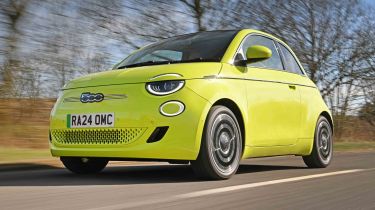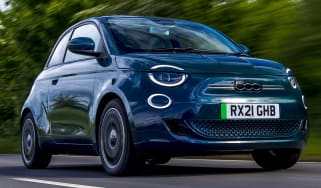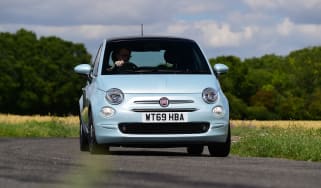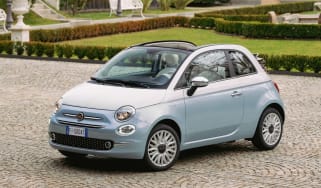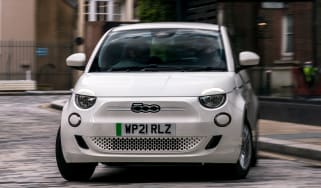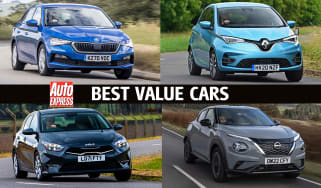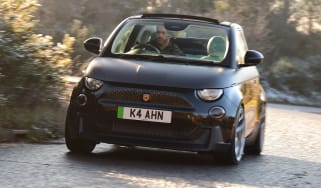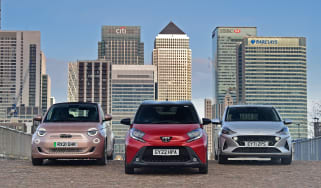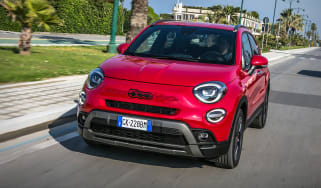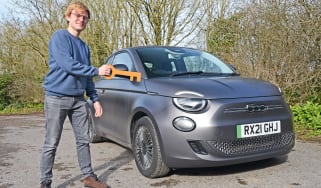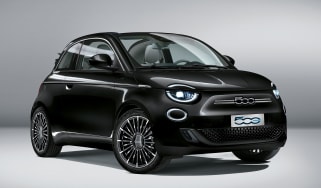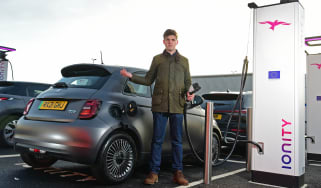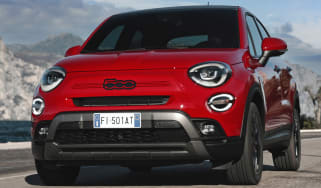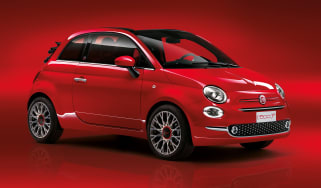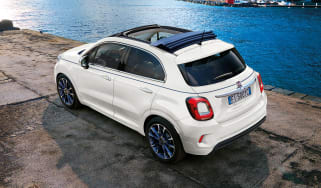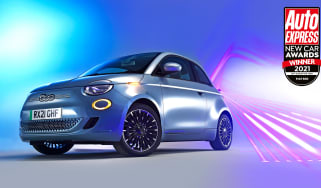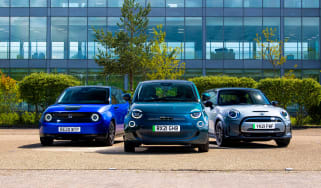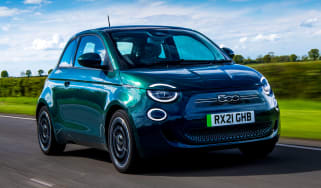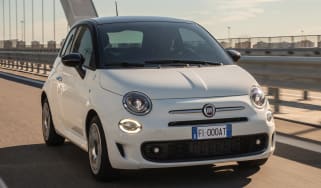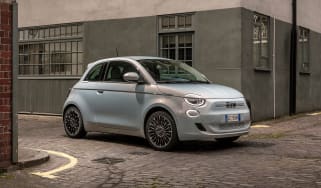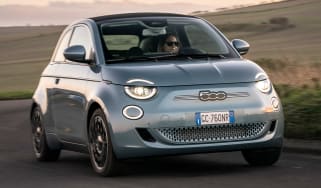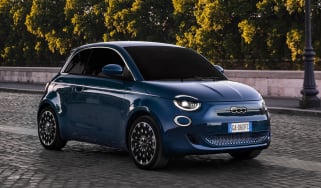Fiat 500e review
The Fiat 500e has been a sales hit for nearly 20 years. How good is the EV version?

Our opinion on the Fiat 500e
The Fiat 500 (or 500e if you want to differentiate the electric model from the combustion-engined version) was one of the first compact electric cars on the market, and as with its petrol-powered namesake, it has plenty of staying power. While cars such as the Volkswagen e-up! and Honda e have disappeared from their respective price lists, the 500e soldiers on against an influx of new rivals, including the similarly priced Renault 5 and Citroen e-C3. It has retro-inspired style on its side, and as a city car it certainly cuts it with the best, although its limitations are easy to see once you head out on the open road for longer trips.
| Key specs | |
| Fuel type | Electric |
| Body style | Three-door small hatchback Two-door small convertible |
| Powertrain | 1x e-motor, 24kWh battery, front-wheel drive 1x e-motor, 42kWh battery, front-wheel drive |
| Safety | Four-star Euro NCAP (2021) |
| Warranty | Three years/unlimited miles |
About the Fiat 500e
The modern Fiat 500e has come a long way since the iconic 1957 city car, and is arguably a completely different animal to the Nuova 500 that arrived in 2007. While the car retains the same recognisable profile as that car, the third generation has switched to all-electric power.
The electric 500e is slightly longer, wider, and taller than the petrol version, but it’s still small when compared with most other new cars. Buyers get a choice of two battery sizes and power outputs in the 500e, although both use a single electric motor to drive the front wheels. The base model has a small 24kWh battery and 92bhp motor, a combination which Fiat says allows the car to cover 118 miles on a single charge.
Used - available now
Add the much larger (and heavier) 42kWh battery, and there’s a range of 193 miles, while power is increased to 116bhp so that the 0-62mph dash still takes around nine seconds. That’s quite nippy for an electric city car, but that hasn’t stopped the brand from introducing the hot Abarth 500e, which provides plenty of extra go in the same diminutive package.
The 500e’s trim structure has been overhauled several times since it launched, including the axing of the cheap and cheerful Action specification, which was so basic that it used a smartphone cradle in place of an actual infotainment system. The three trim levels currently available are the unnamed base 500e, top-of-the-range La Prima and the limited-run Armani Edition.
Prices for the electric 500e start from around £25,000, making it among the cheapest EVs on sale right now. Upgrading to the bigger battery increases the price tag to around £28,000, while the 500 BEV Convertible (BEV stands for Battery Electric Vehicle) starts from around £31,000.
Performance & driving experience
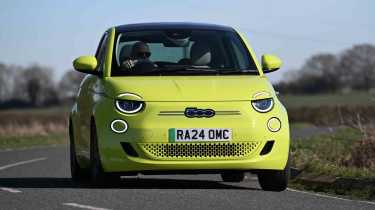
| Pros | Cons |
|
|
The Fiat 500e is a car that’s very clearly been designed with the city in mind, and that’s without doubt where it does its best work. With up to 220Nm going through the front wheels, throttle response is lively enough to provide plenty of punch when pulling out of junctions or away from traffic lights.
But it’s a pity the brake regeneration modes are tied to the driving modes. If you want one-pedal driving (or at least close to it) then you must pick one of the more efficient settings. But these also peg back the power, especially the Sherpa mode, which is designed to eke out as much distance as possible from the battery.
Electric motors, 0-60mph acceleration and top speed
Buyers get a choice of two motor and battery combinations, and while neither delivers the exaggerated performance specs that we’re used to in modern EVs, they’re more than up to the job. The range kicks off with a 92bhp motor that will accelerate from 0-62mph in 9.5 seconds. The 116bhp option knocks half a second from that benchmark, and adds 9mph to the top speed – hitting 93mph flat out.
Town driving, visibility and parking
Being a city car, it’s at low speed where the 500e is designed to excel – and it does. Great visibility, tiny dimensions and a tight turning circle make everything from parking to darting in and out of traffic a doddle. Engaging your desired direction of travel is as simple as prodding one of the large buttons on the dash, and the power delivery is smooth and silent.
It’s clear from the outset that electric power is perfect for a small car, because it’s so much more peaceful, easier and relaxing to drive than an equivalent petrol-powered city car. Avoid the largest wheel sizes and you can make the most of a fairly soft-riding car that soaks up the worst of the UK’s urban streets.
B-road driving and handling
The 500e’s relative lack of weight compared with most other small EVs makes it feel fairly agile along a twisty road. Beyond that, it’s more competent rather than fun. The grip from the fairly modest tyres is fine, and the car is set up to be predictable and nose-heavy, with a very cautious stability control system. The suspension struggles to keep up with higher-frequency bumps as the speed increases, so on a typical British B-road, things can start to get a little bouncy.
Motorway driving and long-distance comfort
The soft ride comes into its own once again on a motorway, where the 500e is fairly comfortable. But this is a very small car, and it’s clear that sound deadening isn’t a priority. Wind and road noise is a little high, even compared with similarly sized rivals such as the Renault 5. The light steering isn’t the most precise as the speed increases either, which means that the driver needs to make regular corrections to keep the car straight.
Expert view, on driving experience
“At a time when so many cars are growing ever larger, it’s worth giving Fiat credit for keeping the 500e nice and compact. At 3,673mm long, it’s almost 200mm shorter than the MINI Cooper Electric, and while the Renault 5 is smaller than many new petrol-powered superminis, the French model is still 249mm longer than its Italian competitor. Without mirrors, the Fiat is 1,682mm wide, which allows it to squeeze through many tight gaps that other small cars can’t. In other words, it’s an ideal size for the city.”
Alex Ingram, chief reviewer, tested the Fiat 500e against the Renault 5 in February 2025.
| Model | Power | 0-62mph | Top speed |
| 500e 24kWh | 94bhp | 9.5 seconds | 84mph |
| 500e 42kWh | 116bhp | 9.0 seconds | 93mph |
Range, charging & running costs
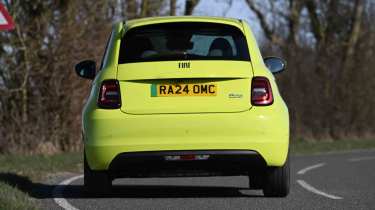
| Pros | Cons |
|
|
The 500e is very efficient and cheap to tax, but you’ll need to hunt out some bargains, because depreciation is very steep.
Electric range, battery life and charge time
In either of its forms, the 500e doesn’t have a very large battery, but then it isn’t a car designed for long motorway slogs. Yet a small battery means that there isn’t so much weight to lug around, and therefore it’s very efficient with the energy that it has.
In temperatures around 17 degrees Celsius, we averaged 4.3mi/kWh on a range of roads, including motorways. Sticking to suburban streets, it climbed as high as 5.2mi/kWh. On a cold day with temperatures just above freezing, a motorway-only run achieved 3.1mi/kWh; given the temperature and speeds involved, that’s likely a worst-case scenario.
Fiat says the 500e’s charging maxes out at 85kW, and quotes a 0-80 per cent battery top-up in 35 minutes. That’s identical to the MINI Cooper E (85kW), but not as swift as the Renault 5 (100kW). The Fiat slows significantly beyond 80 per cent, with that final fifth of the battery taking closer to 50 minutes to top up.
| Model | Battery size | Range | Insurance group |
| 500e 24kWh | 24kWh | 118 miles | 16 |
| 500e 42kWh | 42kWh | 200 miles | 18 |
Insurance groups
Insurance cover for a 500e shouldn’t be too expensive, with the entry-level 24kWh version rated at group 16, and the 42kWh variant just one to two groups higher. The 500 BEV Convertible version will be slightly more pricey, given that it starts in group 21.
Tax
If you’re in the market for a small company car, then the 500e will prove to be very cheap. As with any other EV, it sits in the lowest tax band, which, as of April 2025, is three per cent, so a basic-rate income tax payer will face deductions of just £186 per year. That’s about a fifth of what the 500 mild hybrid costs over the same period.
Depreciation
Electric cars have gained a sometimes undeserved reputation for hefty depreciation. Many EVs lose their value at a similar rate to petrol and diesel cars. As for the ones that are too expensive in the first place, the used car market takes care of those values, and they lose a huge chunk of their retail price very quickly.
Unfortunately for Fiat, the 500e is one of the heaviest-depreciating cars on the market right now. According to data supplied by industry advisors CDL Vehicle Information Services, rivals such as the Renault 5 hold on to roughly half of their value after three years or 36,000 miles, but the Fiat clings onto barely one third of its original asking price.
In the case of the most expensive trim level, the Giorgio Armani special edition, it’ll be worth just 31.25 per cent of its original list price three years down the line. In other words, that £33,995 car will become a £10,625 model in 36 months. The one positive spin that you can put on those numbers is that the 500e is already a used-car bargain.
Interior, design & technology
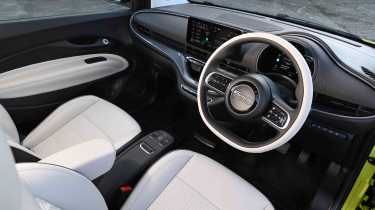
| Pros | Cons |
|
|
Despite having a clean sheet to explore new designs with the Fiat 500e, the Italian manufacturer wisely decided to go with an updated version of its trusted retro formula as the petrol 500 city car that arrived back in 2007.
The third-generation all-electric model is slightly bigger than the petrol version, but it still retains the unmistakable family looks. The split headlights at the front add a modern touch, and some of the alloy wheel designs really stand out, while inside the cabin a body-coloured section across the dash pays homage to the original car. You’ll have to decide for yourself whether the buttons to open the doors add to the appeal or are a bit gimmicky, and the same goes for the sound effects that play when you switch the car on or off.
Interior and dashboard design
Fiat’s design team played a bit of a blinder with the styling of the 500e’s cabin, delivering a look that maintains some smart retro touches while taking advantage of the manufacturer’s latest touchscreen technology and electric layout.
The use of painted plastic or textured material (depending on spec) on the top of the dashboard doesn’t just create a throwback to the original 500, but also adds a splash of interest where most cabins ordinarily have dull, cheap black plastic.
Interesting upholstery designs and a quirky steering wheel also add character to a car which disguises the fact that, like most very small cars, it’s been built to a cost.
Materials and build quality
There are lots of hard plastics around the 500e’s cabin, but thanks to many of the most common touchpoints feeling expensive – and the previously mentioned use of colours and textures – the 500e feels very smart inside.
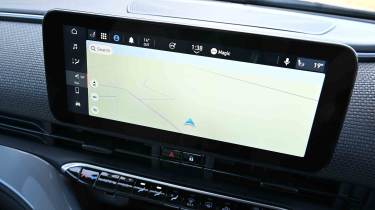
Infotainment, sat-nav and stereo
With many tiny electric vehicles such as the 500e still being a bit pricey compared with their petrol counterparts, Fiat has tried to justify that initial expense to some degree by loading this small car with plenty of smart technology.
There’s a 10.25-inch touchscreen, a seven-inch digital driver’s display (neatly integrated into a round binnacle – another clever nod to the original 500), while top-spec trims get semi-autonomous driving tech that can accelerate, brake and steer the car within lanes without driver input.
Fiat’s bright, hi-res screen is fairly responsive, but loading times for the UConnect 5 system between selecting menus – especially the nav pages – can be sluggish. Disabling the lane-keep system is fairly easy, thanks to a button on the end of the left-hand stalk. That’s handy because turning it off via the touchscreen requires diving into some messy sub-menus.
Small switches on the back of the 500e’s steering wheel spokes make it easy to adjust the volume and switch radio stations, or skip song tracks when on the move.
Expert view, on design
“Buyers get a decent amount of tech as standard in the 500e, with a 10.25-inch touchscreen with Apple CarPlay and Android Auto connectivity, a digital driver’s display, keyless entry, automatic wipers, traffic-sign information and cruise control all included.”
Dean Gibson, senior test editor, conducted the first Fiat 500e road test in 2021.
Boot space & practicality
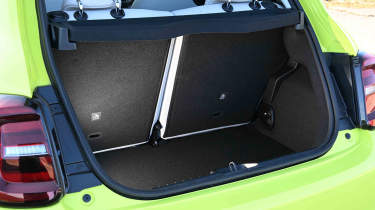
| Pros | Cons |
|
|
Boot space & practicality
The 500e is a very small car on the outside, so space is fairly limited on the inside, too. There are more spacious alternatives for the money.
Dimensions and size
The Fiat 500e is tiny relative to any new car that you compare it against. It’s a lot less than four metres long, while a 1.7-metre width means you’ll barely need to slow down to judge your clearance for urban width restrictions.
Having said that, the old Fiat 500 is minuscule when compared with the current model. At three metres long, 1.3 metres wide and an identical height, the modern 500e simply dwarfs its ancestor.
| Dimensions | |
| Length | 3,632mm |
| Width | 1,682mm |
| Height | 1,527mm |
| Number of seats | Four |
| Boot space | 185-550 litres |
Driving position, seats & space in the front
Visibility from the 500e’s driver’s seat is excellent. In almost every direction, there are large windows, with no unnecessarily large pillars or a rising shoulder line to obstruct vision. The view is boosted further by the high driving position – the seat is height adjustable in some models, but the position is fairly lofty even in its lowest setting. There’s plenty of adjustment in the steering wheel, but the pedal box is a little cramped, and there’s no left foot rest.
While the glovebox is large, the door bins are small. The console between the front seats has a space under the adjustable armrest, while a sliding cover hides an extra bin with a cup-holder. It’s set very deep, though, so extracting a hot drink demands caution.
Seats & space in the back
The 500e is strictly for four people only, with no centre rear seat or belt. That’s probably for the best, because the cabin would be too narrow for three. As it is, shoulder room is absolutely fine, but headroom is tight and legroom is in short supply. If the driver is above average height, their seat will be squashing the knees of anybody sitting behind them. While you can fit adults back there, the second row is best suited to children.
Boot space
At 185 litres, the 500e’s boot is fine for a supermarket trip, but its shape doesn’t lend itself to anything more bulky. The space is fairly deep – making it a little more tricky to lift heavy items over the high load lip – but there is space for the charging cables beneath the false floor. The rear seats split down the middle, but they don’t fold flat, which in part explains why the 500e’s seats-down volume is a still-compact 550 litres.
Expert view, on practicality
“You’re not going to buy a Fiat 500e as a family car, and really it makes most sense to buyers looking for a second car that’s needed for short journeys and quick trips to the shops. The back seats are just as useful for carrying bags, while the 500 BEV Convertible doesn’t demand any real compromise when it comes to carrying capacity, just a smaller boot opening to load items through.”
Dean Gibson, senior test editor, conducted the first Fiat 500e road test in 2021.
Reliability & safety
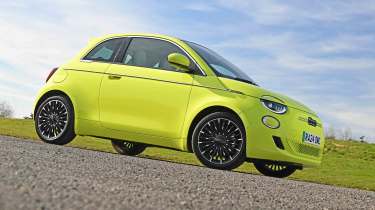
| Pros | Cons |
|
|
Only MG fared worse than Fiat in our 2024 Driver Power customer satisfaction survey manufacturer rankings, with the Italian firm finishing 31st out of 32. Unsurprisingly, for a brand selling so many small cars, interior space and practicality were two areas where it fared worst, while insurance and running costs were two of Fiat’s higher-scoring categories.
The 500e scored four stars out of a maximum five when it was tested by Euro NCAP in 2021. While overall occupant-protection scores were good, it was marked down for the lack of a central airbag, which would reduce the risk of injury between two front occupants colliding in the event of a side impact.
| Key standard safety features | Euro NCAP safety ratings |
|
|
Buying and owning
- Best buy: Fiat 500e 42kWh La Prima
The larger battery is an option we’d definitely choose for its added peace of mind and faster DC charging. La Prima feels like an upmarket model with lots of neat detailing and chrome trim adding some class to proceedings.
The 500e comes with a three-year/unlimited mileage warranty – the latter not a massive factor in a model that’s likely to cover fewer miles than the average new car anyway. In what is becoming the industry standard, Fiat offers an eight-year battery warranty.
Fiat recommends the 500e is serviced every 9,000 miles or 12 months. That shouldn’t be an issue for anyone using it as an urban runabout. But if you cover more miles, then the relatively short intervals may prove frustrating, especially when electric cars need far less maintenance than petrol cars.
Alternatives
The small, affordable electric car market isn’t as well established as other sectors, but there has been quite a bit of change in it. When the Fiat 500e electric was launched, its main rivals were the Honda e and MINI Electric. The former has since been discontinued, while the latter has been replaced with a model named MINI Cooper.
Other options have popped up since: the Ora 03 (formally known as the Funky Cat), and the electric versions of established superminis such as the Peugeot E-208 and Vauxhall Corsa Electric. However, the 500e is also facing some stiff opposition in the form of the Citroen e-C3, Auto Express’s 2024 Car of the Year, while the Dacia Spring and Hyundai Inster offer chunky looks and an SUV vibe.
Perhaps the toughest opposition for the 500e is the Renault 5 E-Tech. It’s a similar price to the Fiat, but has a bigger battery for a longer range, has more space inside and is just as capable around town as the 500e, while being far better suited to country roads and motorways.
Fiat 500e pictures
Frequently Asked Questions
While we were fans of the Fiat 500e when it first arrived, there have been big changes in the small electric car market that means it’s no longer one of our class favourites. It still has appeal if you’re going to use it largely in town and without carrying many passengers or shopping, though.
